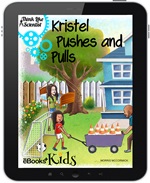What a Misplaced Mattress Teaches Kids About Scientific Push and Pull Forces
By Carole Hayward
Posted on 2018-05-22
 Good morning! Time to head out the door and start the day.
Good morning! Time to head out the door and start the day.
Wait. What’s that thing up there in the tree? It’s … a bed. And it’s hanging upside down.
Huh?
How did that happen?
So Begins a Delightful Mystery
Curious students will have fun solving the mystery in Kristel Pushes and Pulls. NSTA author Morris McCormick’s eBooks+ Kids Enhanced E-book combines engaging, full-color graphics with dynamic enhancements and interactive features for students to learn, share, and explore. Animations, simulations, and video bring content to life, while pop-up review questions and special notes help underscore the most crucial points of knowledge.
This interactive e-book takes students through a day in Kristel’s life, one in which she explores push and pull forces. Students seek answers to questions such as how forces cause objects to change position or move different distances, as well as change speed and direction. Each of Kristel’s normal, every-day activities, such as eating breakfast, cleaning her room or playing soccer, become opportunities for students to figure out just how that bed came to land on the tree in her front yard.
Real-Life Content (and Context)
McCormick, who has been an elementary school educator in the Los Angeles School District for well over a decade, used his professional as well as personal expertise to form the book’s content. His daughter served as the inspiration for Kristel, the lead character. Observing how his own children engage with technology at home, as well as his students in the classroom, McCormick knew that a good story needed to be embedded within this engaging teaching tool to encourage kids to want to explore it.
Where the e-book started conceptually, McCormick admits, was nothing like where ended up.
“In Round I, I was asking myself, ‘What have I gotten myself into?’” McCormick laughs in recalling the creative process.
“I wrote a story … much more like a Dr. Seuss children’s book. After much conversation with my editor, I knew that I needed to build in curriculum and a teacher’s manual. With that expert guidance, I was able to flesh out how to do this.”
The events in the story were intentionally chosen so that children everywhere could relate. The same thought was given to making Kristel’s family ethnically diverse, McCormick added.
“We are a racially blended family; my own family mirrors what America looks like. I wanted kids everywhere to ‘see’ themselves in this book.”
McCormick, who admits to being old enough “to remember using a rotary phone,” welcomes the addition of teaching tools such as Enhanced E-books.
“I would love to see teaching tools like this be transformed into virtual reality where kids are transported right into the story,” he said.
“The kids we are teaching today? Everyone is connected—even in the poorest neighborhoods,” he added. “I teach in a Title I school and at least half of my students come to the classroom with an electronic device. Our students today will be coding at whatever job they do in the future. They will be exponentially ahead of where we are in school right now.”
The Student Becomes the Teacher
McCormick now teaches in the same credentialing program that he went through in becoming certified to teach.
Teachers, he stressed, must catch up. With their own students.
“We teach children to be lifelong learners. I’m a National Board-certified teacher. I have to continue to learn to keep my certification current. We have to change what we are teaching in our credentialing programs. New teachers need to be prepared for today’s classrooms and to be able to grow with their students.
“Student engagement is everything,” McCormick explained. “If we can get student buy-in, then learning happens. We have to meet students where they are. Think about adult learners at a professional development conference. If we don’t like what we are hearing, what do we do? We get up and leave. Unfortunately, children don’t get that opportunity. We have to understand what children want to learn and get their buy in. I do this with my own children at home; why should the classroom be any different?”
Survey after survey confirms that kids use technology at home that harnesses their attraction for learning. Through entertainment, McCormick said.
“An e-book can replicate this. It brings that piece of entertainment to learning.”
As for what’s next for this NSTA author? He’s already conceptualizing his next NSTA e-book. He admits that the pressure is on him to “produce.”
“My son … he’s seen his sister ‘on the big screen’ in our house, so he’s asked, ‘Where am I, daddy?’”
“I told him that he’s in the next book.”
Learn about other titles in the eBooks+ Kids series.
About the Author: Morris McCormick is a graduate of CSUN (ACT-Elementary Ed)/ MA-Curriculum & Instruction). He’s National Board Certified (Middle Childhood Generalist), Level 2 Google Educator, and a trainer for the Boston Museum’s Engineering is Elementary curriculum. He currently teaches at Arminta Street Elementary in North Hollywood, as well as, ‘Math Methods’ courses at Cal State Northridge.
The mission of NSTA is to promote excellence and innovation in science teaching and learning for all.
Follow NSTA
Disclaimer: The views expressed in this blog post are those of the author(s) and do not necessarily reflect the official position of the National Science Teaching Association (NSTA).


